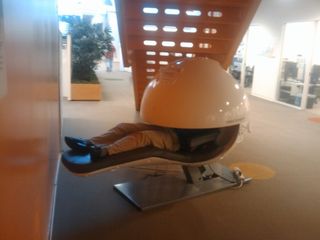Every hiring manager is, at some level, a salesperson. You’re selling the idea that a candidate will experience a better quality of work life in your organization compared to staying with their current employer. But, it’s difficult to sell something effectively if you’re not experiencing the “better quality” yourself.
Last week, I mentioned that I’d focus my next few WorkPuzzle discussions around the topic of engagement—how to experience engagement yourself, how to make sure that those on your team are experiencing it, and how to make this topic a key component of your recruiting message. Today, we’ll work on how you can feel more engaged in your role as an owner, team leader, or hiring manager.
Researchers have well-documented the notion that in order to find engagement in a job, your personal strengths have to be aligned with the tasks that you’re doing on a day-to-day basis. For employees who work in structured jobs (typically below the middle manager level), this reality tends to have a significant impact on the engagement they feel. This is often referred to as job-fit. If a person does not happen to fit the structured tasks required to perform the job, it is difficult to be excited and engaged in the work.
But, for most positions middle-manager and above, a person can adapt the job to match his or her own strengths. So, job-fit tends to have a diminished impact. Instead, the way the job is performed by the individual (and how that work integrates into the rest of life) is more predictive of the type of engagement a person will experience. In essence, if you can figure out how to work well, you’ll find engagement in your work.
Researchers have invested heavily in this subject over the last ten years, and best-selling authors, Tony Schwartz and Jim Loehr, have done a great job of summarizing much of the research on this topic in a best-selling book called "The Power of Full Engagement" (2003). As I previously mentioned, Schwartz recently completed a follow-up solo project with updated information called "The Way We’re Working Isn’t Working."
Schwartz describes the lack of engagement problem this way:
“We live in a world of infinite distractions and endless demands. Many of us juggle several tasks at a time and struggle to focus on any one of them very long. Lack of absorbed focus takes a toll on the depth and quality of whatever we do, and it’s also an inefficient way to work, extending the time it takes to finish any task….
Most of us work long hours and feel a restless sense of urgency. We juggle multiple demands without feeling we’re devoting sufficient time to the most important tasks. We arrive home in the evenings with little energy left for our families. We spend too little time thinking strategically and long term, too little time taking care of ourselves, and too little time simply enjoying our lives…. Is the life you’re leading worth the price you’re paying to live it?”
If you’re in any type of leadership role in your company, I’m sure this resonates with you because it is exactly the type of disengagement that leaders struggle to keep under control. If you want to attract the best talent to your organization, you must address the issues that cause this type of disengagement. People are inspired to work for a leader who has his/her own life in order.
How do you fix these problems in your own life? Unfortunately, there are no shortcuts or quick answers. Schwartz describes the process as “transforming the operating system” of your life. This means creating an inventory of the habits that drive your poor behaviors and then systematically replacing those habits with new rituals that produce the desired behaviors and actions.
This is easier said than done! In the last few weeks, I’ve tried to change just a couple of the harmful habits in my personal workflow, and I’m amazed at the internal resistance I’m facing. I’m not going to give up, but I also don’t want to come across as unsympathetic as I suggest you address these issues. I do believe that it's worth the effort—both for our personal well-being, and our ability to recruit.
Here are two new things I learned as I worked through Schwartz’s book:
1. The body and mind work best in rhythms.
All systems in our body pulse rhythmically when we’re healthy—heartbeat, brain waves, body temperature, blood pressure, and hormone levels. Our fundamental need is to spend and renew energy. The mind works on the same rule.
This principle has all kinds of implications. Every area of your life—eating, movement, sleep, relationships, and work- functions optimally if it has a rhythm to it. For example, your workflow will be most productive if you are able to work intensely (without distractions) for a period of about 90 minutes. This 90 minute period is then best followed by a period of low mental intensity (emails, most meetings, errands, etc.). By repeating this cycle several times during the day, your overall productivity and engagement will increase.
2. Physical routine has significant impact on your performance and sense of engagement.
There are three important components to a physical routine: (1) sleep, (2) exercise, and (3) diet:
 Sleep is the foundation of all physical energy. No single behavior more fundamentally influences our effectiveness in waking life. Sleep deprivation takes a powerful toll on our health, our emotional well-being, and our cognitive functioning. The only viable solution to insufficient sleep is to go to bed earlier.
Sleep is the foundation of all physical energy. No single behavior more fundamentally influences our effectiveness in waking life. Sleep deprivation takes a powerful toll on our health, our emotional well-being, and our cognitive functioning. The only viable solution to insufficient sleep is to go to bed earlier.
Secondly, regular exercise, especially intense energy expenditure followed by deep recovery, dramatically increases our capacity, not just physically, but also mentally and emotionally. Ideally, we should be doing some sort of moderately intense physical activity six days per week for twenty to forty-five minutes a day. That time can be split between two or three sessions over the course of a day, so long as each is at least ten minutes long.
Finally, how we eat (not just what we eat) has a significant impact on overall performance. The key to nutrition is maintaining a stable level of blood sugar. Food is our primary source of glucose, and it fuels not just our bodies, but also our brains. Small, frequent meals serve us better than two or three large ones. To maintain a steady source of energy, it’s best to eat something at least every three hours—that is five or six “small meals” a day. Avoid the foods that provide a quick hit of energy but dissipate quickly. And if you feel like you really need at least one big meal a day—eat a big breakfast.
As you can tell, I’ve just scratched the surface on this topic. There is much more to learn and implement. Hopefully, this information will jump start your efforts toward finding engagement in your work. Next, we’ll discuss how to lead a team that is just as engaged as you are...
Editor's Note: This article was written by Ben Hess. Ben is the Founding Partner and Managing Director of Tidemark, Inc. and a regular contributor to WorkPuzzle. Comments or questions are welcome. If you're an email subscriber, reply to this WorkPuzzle email. If you read the blog directly from the web, you can click the "comments" link below.
 Despite the fact that we have sourced approximately 950 total candidates to date this year for them, they have interviewed 232, and hired 48 new agents. This means they have interviewed 25% of ALL candidates and hired 21% of those interviewed!
Despite the fact that we have sourced approximately 950 total candidates to date this year for them, they have interviewed 232, and hired 48 new agents. This means they have interviewed 25% of ALL candidates and hired 21% of those interviewed!










